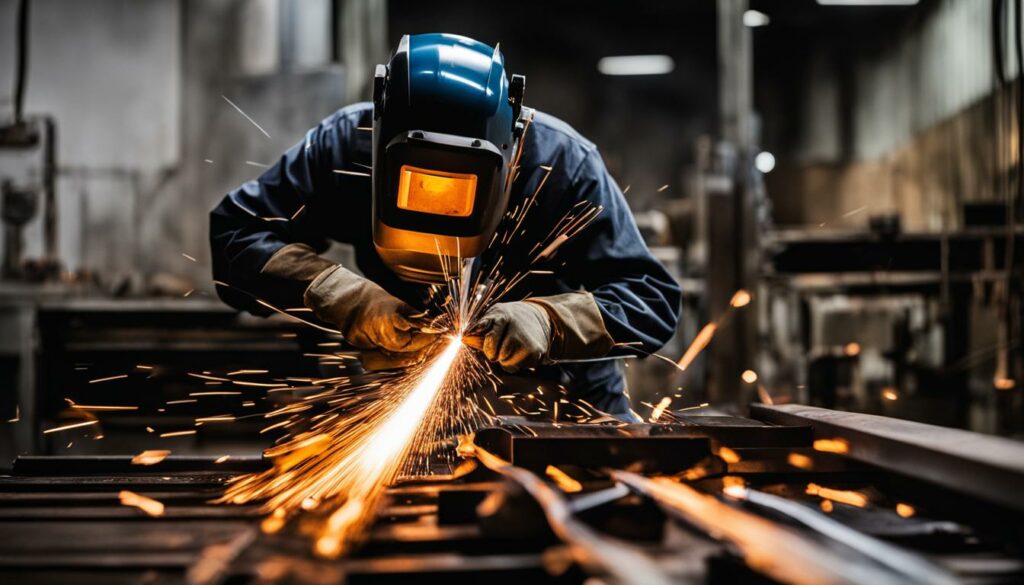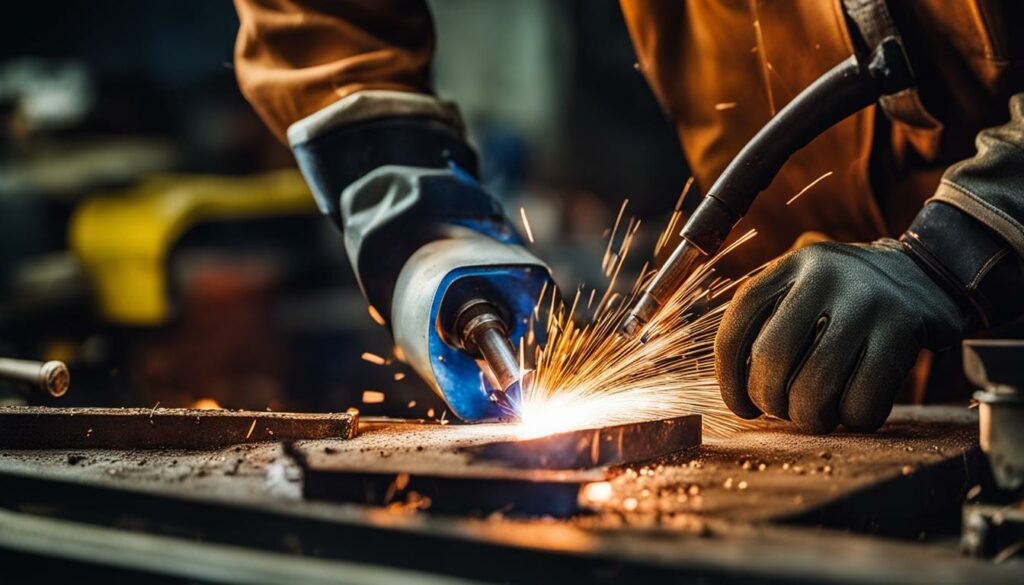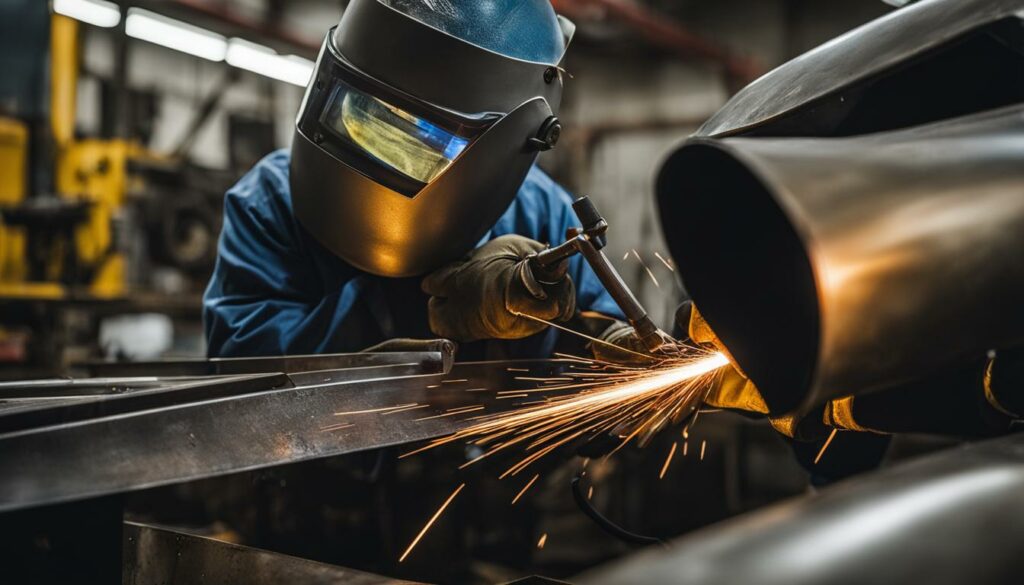Completing auto mechanic training provides hands-on learning and understanding of successful welding techniques. The curriculum includes welding fundamentals and guidance on various techniques. Five welding techniques that can be practiced during technician training include MIG welding, TIG welding, stick welding, arc welding, and laser beam welding. Each technique has its own advantages and considerations, such as the type of metal it can weld and the level of experience required.
Whether you’re an aspiring auto mechanic or looking to expand your skillset in automotive body repair, mastering automotive body welding techniques is crucial for success. With the right techniques and practices, you can achieve high-quality welds and enhance your career in the auto industry.
Key Takeaways:
- MIG welding, TIG welding, stick welding, arc welding, and laser beam welding are essential automotive body welding techniques.
- Each technique has its own advantages and considerations, such as the type of metal it can weld and the level of experience required.
- Balancing heat and wire speed is crucial for achieving the best weld with minimal distortion in MIG welding.
- TIG welding offers precision and is popular in custom car and motorcycle applications.
- Stick welding is suitable for equipment repairs and can handle rusty, dusty, or painted surfaces, although it may not be ideal for thin metals.
MIG (Metal Inert Gas) Welding for Beginners
MIG welding is a popular technique used in automotive body repair due to its simplicity and versatility. It is ideal for beginners who are learning automotive welding and want to achieve high-quality welds. MIG welding can be used to join common metals like carbon steel, stainless steel, and aluminum.
To perform MIG welding, you will need a MIG welder, which feeds a continuous wire electrode through the welding gun. As the wire is fed, an inert gas, usually a mixture of argon and carbon dioxide, is expelled to shield the welding area from contaminants like oxygen and moisture. This shielding gas is essential to prevent oxidation and ensure a clean weld.
One of the advantages of MIG welding is its ability to weld different thicknesses of metal with ease. To achieve the best weld, it is important to balance the heat and wire speed. The heat settings and wire speed can be adjusted on the MIG welder to match the thickness of the metal being welded. This helps to minimize distortion and produce strong, durable welds.

Overall, MIG welding is a great technique for beginners in automotive welding. It offers simplicity, versatility, and the ability to weld various metals effectively. With proper training and practice, you can master MIG welding and create high-quality welds for automotive body repair.
TIG (Tungsten Inert Gas) Welding for More Experienced Welders
In the realm of automotive welding, TIG (Tungsten Inert Gas) welding stands out as a more advanced technique that requires expertise and precision. Unlike MIG welding, TIG welding does not use a filler metal, instead focusing on joining the two metals directly. This technique is widely used in custom car and motorcycle applications due to its ability to produce visually appealing welds.
TIG welding relies on a tungsten electrode that creates an arc to heat and melt the metals being joined. It uses an inert gas, such as argon, to shield the weld pool from oxidation and other contaminants. The absence of a filler metal means that TIG welding can produce highly precise and clean welds, making it a preferred choice for delicate automotive body repairs.
Mastering TIG welding requires practice and patience. The technique demands steady hands and precise control over the welding torch. Welders must also adjust the heat input and manipulate the filler rod with finesse to achieve the desired results. With consistent practice and a thorough understanding of the materials being welded, automotive technicians can become proficient in TIG welding and unlock its full potential in their repair and restoration projects.
| TIG Welding Advantages | TIG Welding Considerations |
|---|---|
|
|
Stick Welding in Auto Mechanic School
The art of stick welding, also known as Shielded Metal Arc Welding (SMAW), is a fundamental technique taught in auto mechanic schools. This method is particularly suitable for equipment repairs and can tackle various challenges like rusty, dusty, or even painted surfaces. Although it may not produce the cleanest welds or be ideal for thin metals, stick welding remains a valuable skill in automotive body repair.
One of the advantages of stick welding is its versatility. It can be used to join a wide range of metals, including steel, cast iron, and even certain types of stainless steel. This flexibility makes it a practical technique for repairing and restoring automotive body panels and frames. However, it’s important to note that stick welding requires some patience and expertise to achieve optimal results.
When learning stick welding in auto mechanic school, you will discover the importance of selecting the right electrode for the job. Different electrodes have varying properties, such as the type of current they require and the type of metal they are best suited for. By understanding these characteristics and practicing with different electrodes, you can develop your skills and become proficient in stick welding.

Advantages of Stick Welding:
- Ability to weld on rusty, dusty, or painted surfaces
- Versatility in welding different metals
- Cost-effective and accessible equipment
Stick welding is a valuable technique to master in auto mechanic school. It may not be the cleanest option, but it offers versatility and the ability to tackle challenging repairs. With practice and proper electrode selection, you can achieve high-quality welds in automotive body repair.
| Pros | Cons |
|---|---|
| Ability to weld on various surfaces | May not produce clean welds |
| Can join a wide range of metals | Not suitable for thin metals |
| Cost-effective and accessible equipment | Requires expertise for optimal results |
Arc Welding With Rod Materials
Arc welding is a commonly used technique in automotive body repair due to its versatility and effectiveness in joining heavy materials. This method utilizes an electrode with a powered flux that creates a weld when it comes into contact with the metal surfaces. The flux acts as a shielding gas, preventing the weld area from being contaminated by the surrounding environment.
When it comes to choosing the right rod material for arc welding, there are several options available. Each rod material has its own characteristics and is best suited for specific applications. Some commonly used rod materials in automotive body repair include:
- Carbon steel rods: These rods are suitable for welding carbon steel body panels and provide good strength and ductility.
- Stainless steel rods: Ideal for welding stainless steel parts, these rods offer excellent corrosion resistance and high strength.
- Aluminum rods: Used for welding aluminum body panels, these rods provide good strength and help achieve a clean and aesthetically pleasing weld.
It’s important to understand the characteristics of each rod material and select the appropriate one based on the type of metal being welded and the desired result. This will ensure a strong and durable weld that meets the required specifications.
| Rod Material | Advantages | Considerations |
|---|---|---|
| Carbon steel rods | Good strength and ductility | Not suitable for welding stainless steel or aluminum |
| Stainless steel rods | Excellent corrosion resistance and high strength | Not suitable for welding carbon steel or aluminum |
| Aluminum rods | Good strength and clean weld appearance | Not suitable for welding carbon steel or stainless steel |
Conclusion
Mastering automotive body welding techniques is essential for professional collision repair technicians. Whether you’re restoring a classic car or repairing a modern vehicle, having a solid foundation in welding is crucial. By practicing a variety of welding techniques, such as MIG welding, TIG welding, stick welding, arc welding, and laser beam welding, you can develop your skills and achieve high-quality welds in automotive body repair and restoration projects.
Each welding technique has its advantages and considerations. MIG welding is a great option for beginners, providing versatility and ease of use. TIG welding is more precise and offers a visually appealing finish, making it popular for custom car applications. Stick welding is still widely used in auto mechanic schools, while arc welding is best suited for heavy materials. Laser beam welding, although less common, offers precise and rapid results.
Remember, safety should always be a priority when engaging in automotive body repair welding. Make sure to wear appropriate personal protective equipment and follow recommended welding practices to minimize risk. With dedication and practice, you can become proficient in automotive body welding techniques and enhance your career in the auto industry. So, start honing your skills, and get ready to create impeccable welds that will stand the test of time!
FAQ
What are the different welding techniques taught in auto mechanic training?
The welding techniques taught in auto mechanic training include MIG welding, TIG welding, stick welding, arc welding, and laser beam welding.
What metals can be welded using MIG welding?
MIG welding can be used to weld common metals like carbon steel, stainless steel, and aluminum.
How does TIG welding differ from MIG welding?
Unlike MIG welding, TIG welding does not use a filler metal and only welds the two metals being joined.
What is stick welding best suited for?
Stick welding, also known as SMAW (Shielded Metal Arc Welding), is best suited for equipment repairs and can handle rusty, dusty, or painted surfaces.
What is the advantage of using arc welding?
Arc welding is best suited for heavy materials and is effective for joining them.
How can I become proficient in automotive body welding techniques?
By practicing MIG welding, TIG welding, stick welding, arc welding, and laser beam welding, you can develop your skills in automotive body welding techniques.

